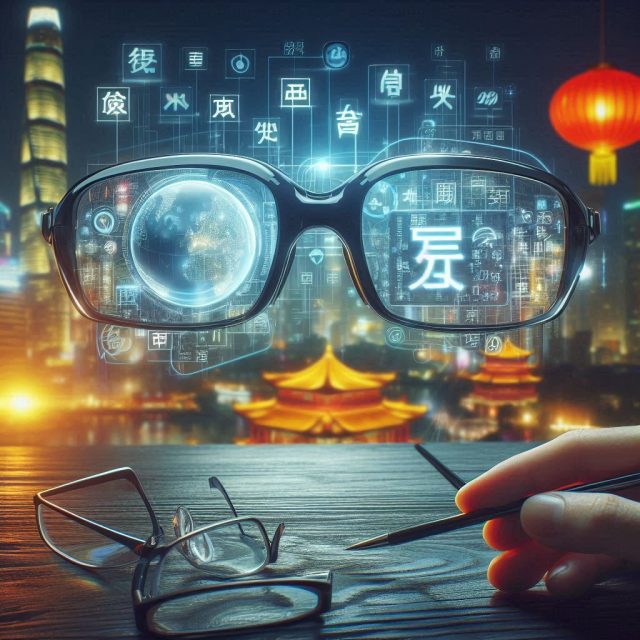In recent years, the fusion of technology and wearable devices has led to the creation of innovative products that aim to make life more convenient. Among these, Chinese translation glasses have emerged as a revolutionary tool, bridging language barriers with the simple act of wearing a pair of glasses. These smart glasses, equipped with advanced translation software and augmented reality (AR) capabilities, are not just a technological marvel but also a significant step towards global communication and understanding.
The Evolution of Translation Technology
Before delving into the specifics of Chinese translation glasses, it’s essential to understand the evolution of translation technology. Over the past few decades, translation tools have evolved from simple dictionaries to sophisticated software capable of interpreting complex languages and dialects. Early translation software was limited, often providing inaccurate or awkward translations. However, as artificial intelligence (AI) and machine learning (ML) technologies have advanced, so has the accuracy and reliability of these tools.
The development of Natural Language Processing (NLP) has been a game-changer in translation technology. NLP enables machines to understand and interpret human language more naturally and accurately. It’s this technology that forms the backbone of the translation capabilities in Chinese translation glasses, allowing for real-time, seamless communication between people speaking different languages.
Break Language Barriers, See the World Clearly.
The Need for Chinese Translation Glasses
China is one of the world’s most populous countries and boasts a rich linguistic diversity. Mandarin Chinese, the country’s official language, is spoken by over a billion people. However, the complexity of the language, with its tonal variations and thousands of characters, poses a significant challenge for non-native speakers. This challenge is compounded by the fact that many regions in China also speak different dialects, some of which are mutually unintelligible even to Mandarin speakers.
In a globalized world, the ability to communicate across language barriers is increasingly important. Whether for business, tourism, or education, the need to understand and speak Mandarin is growing. Traditional translation methods, such as dictionaries or smartphone apps, can be cumbersome and slow, often disrupting the flow of conversation. Chinese translation glasses address these issues by providing an instant, hands-free translation experience, allowing for more natural and uninterrupted communication.
How Chinese Translation Glasses Work
Chinese translation glasses are a sophisticated blend of hardware and software. At their core, these glasses are equipped with high-definition cameras, microphones, and speakers. The cameras capture the text or speech that needs to be translated, while the microphones pick up spoken language. This data is then processed by built-in AI-powered translation software, which converts the input into the desired language.
The translation is then displayed on the lenses of the glasses using augmented reality. This AR display allows the user to see the translation overlaid on their field of vision, almost as if the translation were a part of the environment itself. The entire process is incredibly fast, often taking just a fraction of a second, allowing for real-time communication.
One of the key features of Chinese translation glasses is their ability to handle complex translations. Mandarin Chinese is a language that relies heavily on context, with many words and phrases having multiple meanings depending on how they are used. The AI software in these glasses is trained on vast datasets of Chinese language usage, enabling it to interpret context and provide accurate translations.
Applications of Chinese Translation Glasses
1. Business and Trade
China is a global economic powerhouse, and many international businesses have established operations in the country. However, language barriers can hinder communication and slow down business processes. Chinese translation glasses can facilitate smoother interactions between Chinese-speaking employees and their international counterparts. Whether in meetings, negotiations, or daily operations, these glasses can provide instant translations, ensuring that everyone is on the same page.
2. Tourism
China is a popular tourist destination, attracting millions of visitors each year. However, many tourists struggle with the language barrier, especially when traveling to regions where English is not widely spoken. Chinese translation glasses can enhance the travel experience by allowing tourists to communicate more easily with locals, read signs and menus, and navigate unfamiliar environments without the need for a human translator or cumbersome translation apps.
3. Education
As China continues to play a significant role in global affairs, more people around the world are learning Mandarin. Chinese translation glasses can be a valuable tool in language education, providing learners with real-time translations and helping them to practice their language skills in a more immersive way. Additionally, these glasses can assist international students studying in China, helping them to understand lectures, read academic materials, and interact with peers.
4. Healthcare
In the healthcare sector, effective communication is crucial. Chinese translation glasses can be particularly useful in hospitals and clinics where medical professionals and patients may not share a common language. These glasses can help doctors, nurses, and other healthcare providers to communicate with Chinese-speaking patients, ensuring that they receive the care they need without misunderstandings or delays.
See, Speak, Understand—Effortlessly.
Challenges and Limitations
While Chinese translation glasses represent a significant technological advancement, they are not without challenges and limitations. One of the primary challenges is the accuracy of translations. While AI and machine learning have improved translation accuracy significantly, they are not perfect. Complex sentences, idiomatic expressions, and cultural nuances can still pose challenges, leading to potential misunderstandings.
Another challenge is the battery life and processing power required to run these devices. The constant need for high-speed processing and real-time translation can drain battery life quickly, limiting the usability of the glasses. Additionally, the processing power required to handle complex translations can result in bulky hardware, making the glasses less comfortable to wear for extended periods.
Privacy concerns are another significant issue. The use of cameras and microphones to capture speech and text raises questions about data security and privacy. Users and those around them may be concerned about the potential for surveillance or unauthorized recording. Manufacturers of Chinese translation glasses must ensure that their devices are secure and that data is handled in a way that respects users’ privacy.
The Future of Chinese Translation Glasses
Despite these challenges, the future of Chinese translation glasses looks promising. As AI and machine learning continue to advance, we can expect translation accuracy to improve further. Future iterations of these glasses are likely to be more compact, with longer battery life and more powerful processing capabilities.
In addition to improving the core translation functions, future developments may also focus on integrating other features, such as facial recognition, which could provide additional context for translations. For example, recognizing a person’s facial expressions or emotions could help the AI software to provide more contextually appropriate translations.
There is also the potential for these glasses to be used in more specialized applications. For instance, in fields such as law or diplomacy, where precise language and understanding are crucial, specialized versions of Chinese translation glasses could be developed to cater to these needs.
Conclusion
Chinese translation glasses are a groundbreaking innovation that has the potential to transform global communication. By combining advanced translation software with wearable technology, these glasses offer a hands-free, real-time solution to language barriers, particularly in the complex and widely spoken Mandarin language. While there are challenges to overcome, the potential benefits of these devices are immense, ranging from business and tourism to education and healthcare.
As the world becomes increasingly interconnected, the ability to communicate across languages and cultures will be more important than ever. Chinese translation glasses represent a significant step towards a future where language is no longer a barrier to communication, understanding, and collaboration. With continued advancements in technology, these glasses could soon become a standard tool for anyone needing to communicate in Chinese or any other language, paving the way for a more connected and understanding world.





